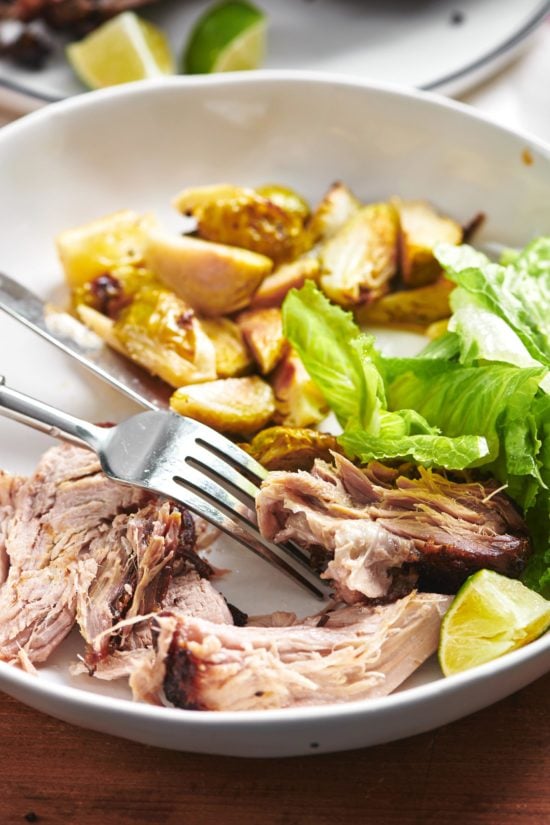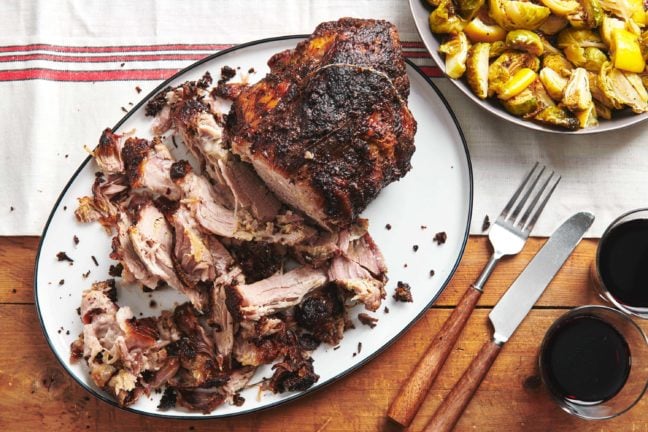A marinated pork shoulder or butt roast recipe that is slow-cooked and very tender. It tastes great on its own and can be used in a lot of different ways. One of my go-to dishes for casual crowd entertaining.
Pork butt roast, also known as Boston butt or pork shoulder is one of the most flavorful cuts of pork you can cook. When prepared properly it turns out incredibly moist, tender and full of deep pork flavor. The key is using the right technique to break down the connective tissues and fat to make the meat fall-apart tender.
In this detailed guide I’ll walk you through everything you need to know to cook pork butt roast to perfection. We’ll cover choosing the right cut prep work, seasoning, roasting time and temperature, determining doneness, plus tips for leftovers and serving suggestions. If you follow these steps, you’ll end up with the most tender, succulent and delicious pork roast.
Choosing the Right Pork Butt Roast
The first step is selecting the right cut of pork at the grocery store or butcher shop. Here’s what to look for:
-
Pork shoulder: This primal cut comes from the front leg/shoulder area of the pig. It contains a good amount of fat marbling which keeps the meat moist during cooking.
-
Bone-in or boneless: Choose whatever fits your preference. Roasts with the bones in take a little longer to cook, but some people like the extra flavor.
-
Weight: Aim for 3-5 pounds to feed 4-6 people. Scale up or down depending on your needs.
-
Color: Fresh pork should be pinkish-red in color with white fat marbling. Avoid any meat that looks brown or gray.
-
Fat cap: Ideally, select a roast with an even 1/4 to 1/2 inch layer of fat on top to keep the meat extra juicy.
Once you have the perfect pork butt, it’s time to start prepping it for the oven.
Preparing Pork Butt Roast for Roasting
Proper prep work ensures your pork roast comes out tender and packed with flavor
-
Trim excess fat: Leave a 1/4 inch fat cap intact but trim off any thick pieces of fat that seem excessive.
-
Score the fat cap: Use a sharp knife to cut shallow slits across the surface fat cap. This allows the seasoning to better penetrate the meat.
-
Apply a dry rub: Coat all sides with a flavorful blend of spices like salt, pepper, brown sugar, paprika, garlic powder, onion powder, chili powder, cumin, and more.
-
Refrigerate overnight: Letting the meat rest overnight allows the spice rub to really sink in. The dry brine also enhances juiciness.
-
Bring to room temperature: Take the pork out of the fridge at least 30 minutes before roasting so it cooks evenly.
Now the roast is all prepped and ready to go into the oven for low and slow cooking.
How to Cook Pork Butt Roast in the Oven
Cooking pork shoulder roast using a low and slow oven method results in incredibly moist, fall-apart meat:
-
Preheat oven to 325°F: This moderate roasting temperature is ideal for breaking down the tough connective tissues.
-
Use a roasting pan: Choose a pan with tall sides to catch all the flavorful pork juices.
-
Place roast fat side up: Putting the fat cap on top allows it to baste the meat as it renders.
-
Roast for 3-4 hours: The total cooking time depends on size, but plan for 1-1.5 hours per pound.
-
Check temperature at 3 hours: Insert an instant read thermometer into the thickest part without touching bone.
-
Cook until 185°F internally: Remove the pork from the oven once it reaches an internal temperature of 185°F.
-
Let rest 20 minutes: This allows the juices to redistribute evenly throughout the meat.
-
Carve and serve: After resting, the pork can be carved into slices or pulled/shredded into tender chunks.
Using this simple roasting method results in a tender and juicy pork butt roast that’s sure to impress. Next, let’s go over some serving suggestions and what to do with any leftovers.
Serving Ideas and Leftover Tips
Pork shoulder roast makes for amazing tacos, sandwiches, soups and more. Here are some ideas:
- Stuff into tortillas or buns for pulled pork sandwiches
- Top with barbecue sauce for pulled pork sliders
- Mix with salsa, beans and cheese for nachos or burritos
- Toss with pasta, veggies and stock for a hearty soup
- Add to scrambled eggs, hash or omelets
To store leftovers:
- Allow roast to cool completely, then refrigerate in an airtight container for up to 4 days.
- Slice or shred the pork and store in freezer bags for 2-3 months.
- Reheat leftovers in the oven at 325°F or in the microwave until warmed through.

Low and Slow and Flexible
The flexibility of this recipe bears repeating, because it’s one of the best things about this dish. It won’t hurt the roast to leave it in the very low oven for another hour, two, or even three. The pork is roasted without a lid, which gives it a great crusty brown outside and a fall-apart tender inside.
Turn the heat up to 450°F if you think it needs a little more browning or caramelization at the end. for 15 minutes before pulling it out of the oven. Let it rest for a while so the fibers can loosen up and the juices can re-group.
Also, if everything goes as planned, the meat will be so soft that the slices won’t stick together. That’s part of the appeal.

Fat Side Down or Up?
You can use bone-in pork shoulder instead of boneless pork shoulder because it will cook in about the same amount of time. Some cook faster than others. The directions say to put the fat side down in the pan so that the top can get a nice crust, but it doesn’t really matter. There is less crusty top when there is fat on top, which kind of bastes the pork as it cooks. Your call, you won’t go wrong.
The best part is that you have time to read, dance, sleep, clean your closet, or save kittens from trees.

FALL-APART BOSTON BUTT PORK ROAST – Award Winning RECIPE
FAQ
How long does it take to cook a pork butt?
How many minutes per pound to cook a pork shoulder roast?
What is the rule for cooking pork roast?
